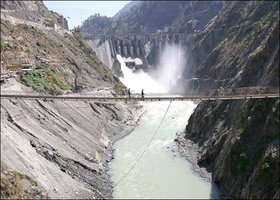
India’s power deficit may rise from 2.6 per cent of peak demand in FY16 to 5.6 per cent in FY22 as demand starts to overtake supply, noted a recent ASSOCHAM-PwC joint study.
“Availability of reliable, affordable and sustainable electricity is an essential requirement for propelling the India growth story and all potential sources of energy will need to be tapped to meet the envisaged demand and ensure its energy security,” highlighted the study titled ‘Hydropower @Crossroads,’ jointly conducted by ASSOCHAM and PwC.
Considering an energy elasticity of 0.8, India is estimated to require seven per cent annual growth in electricity supply to sustain annual gross domestic product (GDP) growth of around 8-9 per cent, it said.
In order to achieve the target of 1,800 kilowatt-hour (kWh) per capita consumption and electricity access for 300 million people by 2034, India will require an additional power supply capacity of 450 gigawatt(GW), as such hydropower, with an abundant 148 gigawatt (GW), can substantially contribute towards meeting India’s energy needs.
Considering that coal-based generation accounts for about 70 per cent of total installed capacity and over 80 per cent of total units generated in India, the study cautioned that such higher dependency on thermal generation sources pose a serious threat to energy security in terms of fuel availability, long-run economic viability and environmental sustainability.
“Hydropower can play a crucial role in India’s sustainable development and energy security given that it meets the criteria of sustainability, availability, reliability and affordability,” said the ASSOCHAM-PwC study.
However, share of hydropower in India’s energy mix has decreased almost by 30 per cent in last 40 years owing to various issues like water sharing disputes, environmental concerns, rehabilitation and resettlement (R&R) issues, land acquisition problems, delays in procuring clearance and approvals, inadequate technical and financial capability of developers.
Considering that hydropower projects are capital-intensive and are faced with various risks and uncertainties, optimum risk allocation mechanisms between developers, government and project affected people need to be in place, suggested the study.
Moreover, new financing avenues need to be developed along with sufficient funding support from the government in order to attract investment in the sector.
Highlighting the need to expedite various clearances, such as those for environment, forest and land, the ASSOCHAM-PwC study suggested the government to form a specialised institution for facilitating large infrastructure projects in terms of clearances and approvals, thereby minimising the time taken for these processes.
Adequate fiscal incentives in terms of tax holiday, Value Added Tax (VAT) exemption, and exemption of custom duty should be allowed by the government to help in reducing hydropower project cost and securing a cheaper source of finance, it added.
Viability gap funding (VGF) can also be a viable proposal to make hydropower projects price competitive, further said the study.
“Government of India may create a special hydropower development fund or can use the clean energy fund to provide loans to hydro projects at a lower rate of interest,” recommended the ASSOCHAM-PwC study.
It has also been suggested that the Central Electricity Regulatory Commission (CERC) should facilitate market-based instruments like hydropower purchase obligations (HPOs), which have an underlying principle of mandatory purchase of hydropower by distribution utilities.
“CERC needs to come up with a differentiated peak and off-peak tariff to incentivise hydropower, given its potential to meet peak demand.”
Hydropower project developers, as a part of economic and social development of the area, need to be mandated to open technical training centres, clinics and health centres, schools, etc., in the project affected area to gain public acceptance and get skilled labour, while local residents get employment opportunities.
“A structured mechanism needs to be developed for balancing benefits from hydropower projects and transferring economic rents from projects to the government, which should ultimately be passed on to affected stakeholders,” the study said.
Besides, hydropower developers should incorporate modern machinery and techniques to enhance their capability to deal with contingencies.






Leave a Reply
You must be logged in to post a comment.